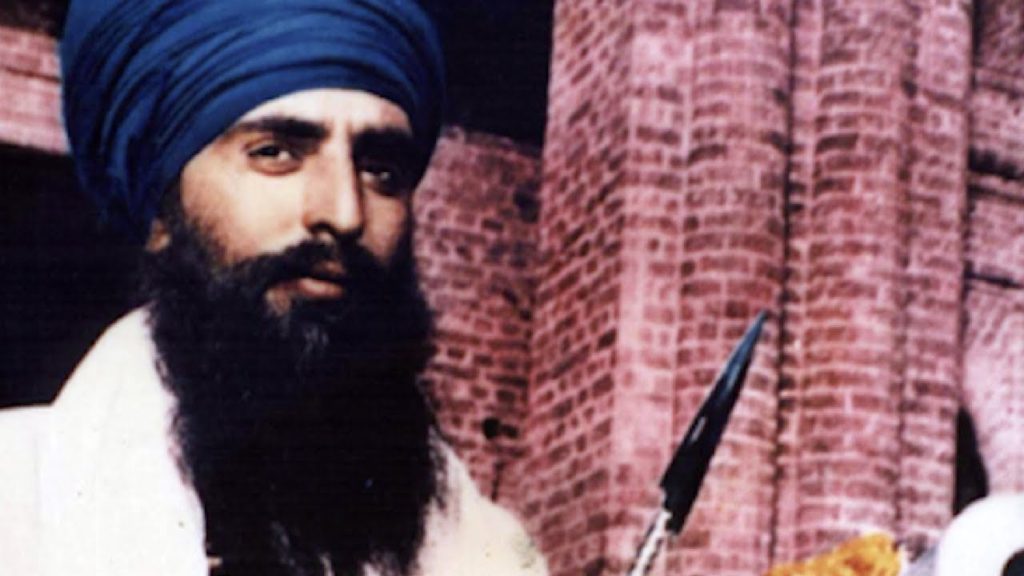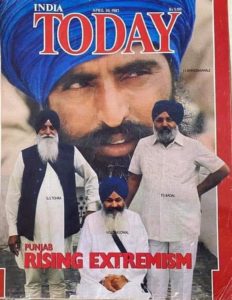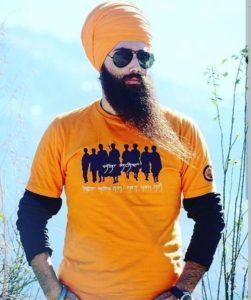Jarnail Singh Bhindranwale -defamed by India, what did he stand for?
What was the significance of this man called Sant Jarnail Singh Bhindranwale? What did he stand for? Why was he dreaded by the Indian state and why was he feared by the Akali leadership? In life and in death, how did he invigorate a generation of Sikhs to focus on Sikh issues and how he made them embrace Sikh consciousness, Sikh national identity and forsake communism and drug abuse. British Sikh, activist-writer Jagdeesh Singh writes that Jarnail Singh outshone the weak, compromising and conniving minds alongside him in the ranks of the increasingly stale, half-hearted Akali Dal leadership and bravely stood up to the Indian leadership.
![What was the significance of this man called Sant Jarnail Singh Bhindranwale? What did he stand for? Why was he dreaded by the Indian state and why was he feared by the Akali leadership? In life and in death, how did he invigorate a generation of Sikhs to focus on Sikh issues and how he made them embrace Sikh consciousness, Sikh national identity and forsake communism and drug abuse. British Sikh, activist-writer Jagdeesh Singh writes that Jarnail Singh outshone the […]](https://www.theworldsikhnews.com/wp-content/uploads/2020/06/Sant-Jarnail-Singh-ji-360x266.jpg)
DURING THE EIGHTIES, IT WAS EVIDENT THAT THE AKALI DAL LEADERSHIP wanted to divert, distract and compromise the defined Panjaab-Sikh agenda of full, maximum territorial autonomy and self-determination within a ‘loose Indian federation.’ Jarnail Singh wanted full delivery of the Anandpur Sahib Resolution, a comprehensive charter of Panjaabi-Sikh rights and demands whilst remaining within a ‘loose Indian federation’; giving Panjaab and Sikhs full autonomy, freedom, specific recognition in law and semi-independence.
The famous Anandpur Sahib da Mata -the Anandpur Sahib resolution, initially expressed in 1973, was a conscientious attempt to achieve a bilateral relationship with the overbearing, centralising Indian state based on equality of status, political sovereignty enshrined and held within Panjaab for Panjaab. and a shared collateral relationship between a central government with minimised and restricted powers and the regional states of the Indian Union having maximum autonomy to conduct and shape their internal and external development.
The essence of this was full self-determination to the regional nations of the Indian Union, and a massive reduction in the disproportionate domineering, and superimposing powers of the ‘centre’ or the ‘Union’ government. The underlying and overlying vision of the Anandpur Sahib Resolution was a comprehensive re-structuring of the Indian Union along confederal (not just federal) lines.
Bhai Jarnail Singh vigorously championed this charter for freedom and self-determination. He repeatedly reminded his fellow colleagues in the ranks of the Akali Dal, SGPC, etcetera, of their solemn public vow to pursue this. He believed intrinsically in the ethics of this historic resolution, which the power-crazed Indian establishment demonised as ‘separatist’ and ‘extremist’.
Bhai Jarnail Singh vigorously championed this charter for freedom and self-determination. He repeatedly reminded his fellow colleagues in the ranks of the Akali Dal, SGPC, etcetera, of their solemn public vow to pursue this. He believed intrinsically in the ethics of this historic resolution, which the power-crazed Indian establishment demonised as ‘separatist’ and ‘extremist’.
Having been denied a return of Panjaabi sovereign statehood in the undemocratic 1947 transfer of power, and pushed into a forced marriage with the over-sized, overpowering Hindu majoritarian centralist Indian state; the aggrieved Sikh leadership was prepared to assert for safeguards and freedoms of a semi-independent state within a loose political framework of the Indian Union.
 Arguably, this was a compromised, second-best option for the Panjaabi-Sikh nation, left completely adrift, powerless, divided, broken and massively displaced in the 1947 genocidal partition. Panjaab nor any other subjugated country of South Asia (whether Balochistan, Kashmir, Bengal, Sindh or other) was freed back to its own pre-British independent life. It was being passed from the frying pan into the fire of the next phase of modern imperialism, whether on the Pakistan side of the border or the Indian side or both. Panjaab was by far the greatest affected nation, from this notorious, undemocratic and genocidal political and territorial carve-up.
Arguably, this was a compromised, second-best option for the Panjaabi-Sikh nation, left completely adrift, powerless, divided, broken and massively displaced in the 1947 genocidal partition. Panjaab nor any other subjugated country of South Asia (whether Balochistan, Kashmir, Bengal, Sindh or other) was freed back to its own pre-British independent life. It was being passed from the frying pan into the fire of the next phase of modern imperialism, whether on the Pakistan side of the border or the Indian side or both. Panjaab was by far the greatest affected nation, from this notorious, undemocratic and genocidal political and territorial carve-up.
Bhai Jarnail Singh or Sant Jarnail Singh, as he is popularly known, openly warned during his life that, whether Indira Gandhi wished to keep the Panjaabi-Sikhs in India as equals, or if not then she should give us a separate state to go our own way. That, we would not repeat the dire mess of 1947 rendering the Sikhs completely stateless. He stated that complete independence was not our immediate demand, but that would be dependent on how we are being treated by India.
Over 1947- 1984, the prime, ideal option of fully independent, sovereign statehood did not appear achievable and tenable, in the circumstances. Full autonomy represented arguably a reasonable, compromised and pragmatic position to try and achieve a balanced and shared power relationship with the Indian state. The intrinsic ideals of self-governance, self-determination and sovereignty over domestic affairs, drove the Anandpur resolution. It stopped short of full-blown independence.
 Jarnail Singh brought an authentic, honest leadership to pursuing this. His matching spoken words and actions revealed a person who was genuine, clear and coherent in what he was seeking and pursuing in an ethical and egalitarian way. He was driven by the historic ideals of the great Gurus and post-Guru-history. His down-to-earth simplicity and passion epitomised a rare kind of person who was ready to stand and fight with defiant courage. This contrasted with the Tohras, Badals and Longowals.
Jarnail Singh brought an authentic, honest leadership to pursuing this. His matching spoken words and actions revealed a person who was genuine, clear and coherent in what he was seeking and pursuing in an ethical and egalitarian way. He was driven by the historic ideals of the great Gurus and post-Guru-history. His down-to-earth simplicity and passion epitomised a rare kind of person who was ready to stand and fight with defiant courage. This contrasted with the Tohras, Badals and Longowals.
He led from his appointment in 1977 as the succeeding head of the much esteemed and highly vigorous Dam Dami Taksal -religio-political seminary, to his ultimate sacrifice in June 1984, joyfully defending and dying along with his comrades in sacred martyrdom for the sovereign shrine of Sikhi and Panjaab – the Darbaar Sahib. He epitomised both eloquently and in, action, in physical form and persona, the saint-soldierly example of Sikh history.
His qualities of humility, simplicity, helping scores of disadvantaged and unjustly treated people who flocked to him for help (including Hindus), coupled with his courageous defiance against the state and police, and proven readiness to stand and fight vigorously to the death.
In June 1984, this figure shone like a bright, shooting star against the many dull, cowardly, compromising motley figures like Harchand Singh Longowal, Parkash Singh Badal, Gurcharan Singh Tohra, Balwant Singh Ramoowalia and more; like a true Panjaabi-Sikh hero in the same tradition of Baba Deep Singh, Bhai Bota Singh, Bhai Garja Singh and Akali Phoola Singh. It would not be wrong to call him the Banda Singh Bahadur of 1980-1984.
His name and image continue to pulsate in the soul of the Panjaabi-Sikh nation. He  is an authentic icon of national liberation and empowerment. Of a new life that is possible, free from the clutches and drudgery and misery of the Indian state. He epitomised not just freedom and independence, but a readiness to question and scrutinise self-assuming ‘leaders’. In true Sikh spirit, he was a peoples person. A grass-roots champion. A real leader! All the more reason for India to demonise him.
is an authentic icon of national liberation and empowerment. Of a new life that is possible, free from the clutches and drudgery and misery of the Indian state. He epitomised not just freedom and independence, but a readiness to question and scrutinise self-assuming ‘leaders’. In true Sikh spirit, he was a peoples person. A grass-roots champion. A real leader! All the more reason for India to demonise him.
For both the Panjaabi-Sikh nation and Jarnail Singh, the decisive moment came with the Indian military onslaught in June 1984. This was another Jalianwala Bagh 1919 but four-fold in intensity and civilian casualties. India had come to crushingly defeat the Panjaabi resistance that had persevered buoyantly up to that point and was ready to move further forward with a cutting off of all grain supplies to rest of India from 3rd June 1984 in a further major step in the Dharam Yudh agitation. A further major heightened phase in the movement was to open. India had, had enough of the defiant and resistant Sikhs! They needed to be put in their place!
Bhai Jarnail Singh and his fellow comrades confronted the Indian army war-like onslaught like true saint-soldiers. The rest is history to be read, studied, to inspire and invigorate us further! Bhindranwale remains alive!


 375
375


